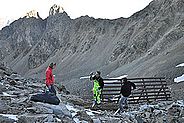Understanding the impacts of climate change on Arctic, Antarctic and Alpine permafrost microbiomes (CRYOLINK)
2017 - 2023
Financing
Cold habitats represent the majority of the Earth’s biomes and permafrost, defined as the part of the soil frozen for at least two consecutive years, are widely spread on land surfaces. The Alpine region with its glaciers and permafrost is particularly affected by climate change. Thawing of alpine permafrost and melting of glaciers are the result of persistently warm conditions during recent years. For a long time, permafrost in the Alpine region was considered as a "sterile ground" in which life can only exist to a limited extent. Nowadays, it is becoming increasingly evident that these areas constitute a unique niche for cold-adapted microorganisms and should be considered as sensitive ecosystems in view of their high susceptibility to global warming.
The interdisciplinary project CryoLink explores permafrost in the Alps, the Arctic and Antarctica as a refuge for microbial life forms. For the first time, samples from alpine permafrost and glacier ice were explored for viral and microbial life. The results were surprising: some like it cold! Up to 1000 different microorganisms and several hundreds of viruses were found in over 12'000 year-old permafrost, about many of which nothing or very little is known so far. It is still unclear how these cold-adapted microorganisms survive in permafrost, how the cells can metabolize and even reproduce. The permafrost microbiome has developed various adaptive strategies to survive under extreme conditions such as nutrient and energy scarcity, no sun light, permanent low temperatures, or low liquid water availability.
Permafrost areas are considered as an ‘extreme environment’ and harbour microorganisms with an ability to adapt, not only to sub-zero temperatures, but also to low water, carbon and nutrient availability. However, these habitats constitute a unique niche for cold-adapted microorganisms. Little information is available on the ecology of microorganisms in permafrost, despite their high importance in view of their high susceptibility to global change.
These microorganisms were trapped in the permafrost and ice for thousands of years. What will happen to them when they are awakened from their "slumber" by global warming? Thawing permafrost threatens to release biological and chemical materials that have been sequestered for tens to hundreds of thousands of years. As these constituents re-enter the environment, they have the potential to disrupt ecosystem function, reduce the populations of native organisms and endanger human health.
Permafrost is an unexploited habitat with many unknown taxa and has the potential to contain novel compounds (i.e., antimicrobials; enzymes for polymer degradation). This immeasurable treasure of unknown microorganisms in ice and permafrost needs to be explored now. Permafrost in the next hundred of years will disappear by climate warming. For this, we have set up an unique collection of microbial strains (Biobank). This collection preserves microorganisms from endangered regions such as the Swiss Alps and contains so far more than 3,000 specimens. Among the microbial life we hope to find microorganisms that could be of interest to medicine and both the pharmaceutical and cosmetics industries.
Many of the microorganisms isolated from permafrost may represent a potentially novel source for enzymes and bioactive compounds that benefit human medicine and biotechnology. Our Biobank consisting of several thousand permafrost-derived strains is, therefore, a valuable resource to examine the potential of natural product formation both via bioactivity assays and genome mining. Our combination of culture-independent microbiota profiling with large-scale bacterial isolation efforts of permafrost soils will allow us to tap into this unexplored treasure of newly chemical compounds which is endangered by increasing temperatures.
The CryoLink project was granted by the Swiss National Science Foundation, Swiss Polar Institute and Ernst-Göhner Foundation to Beat Frey and started 2017.
Projects
Publications
Contributions to newspapers, TV and radio
-
TV-Broadcasting SRF/RTR Cuntrasts, 27th of March 2022: Schmelzen von Permafrost
-
Deutschlandfunk (Radio), 4th of December 2021: Folgen des Klimawandels / Die Alpen in Bergnot
-
OggiScienza, 25th of November 2021: Vita tra i ghiacci
-
Der Spiegel, 25th of September 2021: Die schlummernde Gefahr aus dem Eis. 39: 96-98.
-
Neue Zürcher Zeitung (NZZ), 28th of August 2021: Krankheitserreger aus dem Permafrost.
-
TV-Broadcasting SRF Einstein, 1st of April 2021: Der Permafrost taut auf: Unberechenbare Gefahr fürs Klima.
-
TV-Broadcasting CGTN Europe, 27th of October 2020: What's lurking in these glaciers?
-
Swissinfo, online publication, 21th of May 2020: Wird eine neue Pandemie aus dem Eis auftauchen?
-
Radio-Broadcasting; SRF2 Radio Wissenschaftsmagazin, 13th of June 2020. Forscher finden neue Bakterienarten im Permafrost
-
Swissinfo, online publication, 20th of June 2020: Swiss researchers identify new bacteria in permafrost.
-
Tiroler Tageszeitung, Magazin, 28th of June 2020. Viele winzige Dornröschen wachen auf.
-
Academic Workshop on mountains and climate change, Invitation of the Swiss Embassy in Belgium, Ghent, 23.01.2020, The Unexplored Alpine Microbiome and their Reactions to Climate Warming.
-
TV-Broadcasting with contribution on permafrost microbiology at Gemsstock and laboratory at WSL, (Prime-Time broadcasting Arte, 8/9/2018 um 20:15 Uhr / SWR, 5/4/2019 /ARD (7/4/2019), "Mythos Gotthard: Pass der Pioniere"
-
Radio-Broadcasting, Radio SRF2 Wissenschaftsmagazin, 20.01.2018: Beat Frey zur Forschung über Bakterien in Böden "Reges Leben im Boden".
-
Tages Anzeiger, 20.3.2016, Eine Schatzkammer auf dem Engadiner Schafberg
-
Tages Anzeiger, 20.3.2016, Eine Gletschermikrobe mag es eiskalt. Zürcher Forscher haben eine neue Bakterienart entdeckt, die selbst bei Minustemperaturen wächst.
-
TV-Broadcasting, 3SAT, Nano, 12. Oktober 2015 Die Steinwüste lebt
-
TV-Broadcasting, Tagesschau SRF, 4. Juli 2015; Bodenforscher finden Mikroorganismen in Gletschern